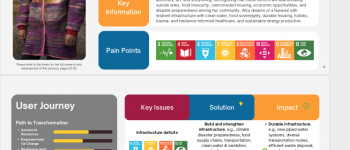Designed with a labour of care, compassion and empathy, this blueprint answers the question:
What changes, adjustments and introductions can be made to help achieve the wellbeing for all of mankind, formulated by the UN Sustainable Development Goals (SDGs), by 2050?
Instead of promoting specific changes, adjustments, or introductions to each UN SDG, or their respective indicators, we offer a reproducible method, which recognizes and honours the interconnectedness of social identities and addresses the systemic inequities that perpetuate marginalization, discrimination, and injustice.
For the 17 UN SDGs to be achieved by 2050, a deeper look into the diverse, context-specific needs, motivations, and challenges faced by different groups within and across communities is required. To do this, we conducted research on extreme end users (more info on page 7) using database and literature research, developed fictional personas to highlight the intersectionality of pressing global issues in localized settings, and created call to actions for each persona.
By creating personas of individuals who are battling the problems of today, solutions can be tailored to be effective, relevant, and community-engaged, fostering a more holistic approach to problem-solving. Ideally, this process would involve meaningful collaboration with communities to co-create the visions we need to build sustainable and resilient futures for all of humankind.
See product (blueprint) live here: https://issuu.com/rcadinitiative/docs/designing_futures_2050_competition_aj_et
The attached blueprint and Annex coalesce our labour of research, thought, coursework, meetings, and discussions on design-thinking, diverse iterations of prototypes, the development of five personas –Malik, Amal, Atka, Fidihasina and Nexus-X– and an annotated bibliography on the gaps of the UN SDGs.
2. Communities disempowered by systemic inequities, particularly black, Indigenous, and people of colour, youth, and children who face challenges related to each of the UN SDGs



 Designing Futures 2050 Competition_AJ&ET.pdf
Designing Futures 2050 Competition_AJ&ET.pdf